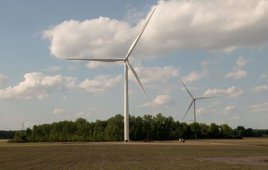
Editor Paul Dvorak
The recent abundance of inexpensive natural gas in the U.S. economy has been good news for the utilities, but less so for participants such as the nuclear and coal industries. The wind industry, it seems to me, is on a sort of cusp. With a few technical improvements, wind turbines could play quite nicely with utilities powered by natural gas. Although the fuel’s price is low (as of August 18, $2.71/billion BTUs at the Henry Hub spot price) it’s bound to head up as more utilities turn to it and away from coal.

A.T. Kearney’s Patrick Haischer
To get a better handle on how the utilities will work with the natural gas and wind industries, we discussed the matter with Patrick Haischer, a partner in consulting firm A.T. Kearney’s Energy Practice. Mr. Haischer has more than 15 years consulting experience with global energy clients. The firm recently commissioned a study on shale gas and its impact on U.S. energy. Haischer was a leader of that study.
To start, how could one quantify the reserves of natural gas? “When we talk about shale gas, we know there is a lot in the ground,” says Haischer. “The key question is: can we get to it and develop it in an economically viable way. So in the first place we should talk about recoverable resources.”
“Considering North America, we know recovering shale gas is feasible. From what is known at this time, it is a fair estimate that there is about 100 years of technically recoverable resources in natural gas at current consumption.” ‘Current consumption’ is a key term, because consumption will certainly rise, and the next 100 years hold more than a few uncertainties.
The rest of the world is not so fortunate. Geology rules. In Europe, the gas is there but it is much harder to get it out of the rock. “For a time, Poland was upbeat, but companies there have pulled back, now thinking that fracking is less feasible,” says Haischer. The potential market in China is significant, but here again the science has not cracked the code to make shale gas economic. Argentina has also some potential but government support remains uncertain, making efforts to prospect for shale gas challenging. So it is important to differentiate between North American and non-North American markets.
What does it take to transform a coal-fired plant into one fired by natural gas?
“When we talk about replacing coal with natural gas, there are three ways to do so. One is that a power generator runs its existing gas plant more and its coal plant less. Many gas plants were used as ‘peakers’ when natural gas was relatively expensive. Now gas plants are pushed into the base load while coal is pushed out. This is what we currently see in the market.”

The natural gas well is in the Marcellus shale region. The condensate tanks are surrounded by a containment barrier in case a tank fails.
The second is converting a coal plant to a gas plant. It happens, but it is not a preferred way. Converting a plant from coal to gas changes the fuel, not the technology. It keeps the standard steam-boiler technology, now powered by gas instead of pulverized coal. The third is building new combined cycle plants, which represent a highly efficient technology. In a nutshell, a gas-fired turbine drives a generator and the exhaust powers a steam turbine.
Now to costs of converting a coal plant to a gas plant. They vary a lot, and Haischer was hesitant to offer figures because a lot depends on multiple factors, such as whether or not the gas pipeline is already there, and if not, how far the plant is from a source. “In the case of one particular project, it was about $400/kW installed capacity for the conversion. For perspective, compare the $400/kW to $1,500/kW for a new gas plant, and about $2,500/kW for a new coal plant. So the conversion from coal to gas, is about one third the cost of a new gas plant. However, building the new gas plant delivers higher efficiencies with the combined cycle, a figure in mid-60% range.
“You can optimize a coal plant, but at the end you rarely reach 40% efficiency. This is one of the factors that makes a positive case for natural gas, in particular from an environmental perspective.
With the price of natural gas likely to change, how do the utilities view its abundance?
“Generally speaking, generators that have the choice to switch to natural gas in the short term by increasing the utilization of their gas plants are doing so, as in most cases there is a strong business case for it. However, multiple factors have to be considered, such as long-term coal contracts,” he says. Some utilities are piling up coal and taking advantage of cheap gas. They are stuck in contracts. “Once gas gets more expensive, they’ll work off the pile — but of course there are limits to that strategy
Looking long term is a little tricky. Utilities have to determine what their future looks like, and it’s easy to bet the house on the wrong technology. The big question for chief strategists at U.S. utilities is which technology to focus on — coal, gas, nuclear, or wind. Billions of dollars are in play.
Some have been stung before, and that experience does not quickly leave their memories. Utility planners easily recall a time 10 to 20 years ago when gas prices bounced around quite wildly while coal was stable and predictable.
Also, everyone understands that the current low gas prices are not sustainable and that they will increase. The questions now are: how far up and when? “If you want an idea of how big U.S. utilities position themselves, a frequent opinion is that they recognize the existing opportunity and will definitely tap in to take advantage. But they want a balanced portfolio, and so keep all options on the table with different technologies as a hedge against everything that can happen, with regard to resources, commodity prices, and regulations,” says Haischer.
Can a utility company buy gas in a long-term contract, as they would with a PPA for wind? “There are cases where generators were exposed to fluctuating gas prices, but were unable to pass on higher costs to their customers. In some cases they went bankrupt.
Now the big question: How do the utilities view the wind-power industry, a help or handicap?
Haischer paused before answering. “I don’t want to put words in the mouths of utilities,” he says, and suggests that utilities and wind operators are not yet best of friends. The simple reason may be grid stability. “The utilities have to stabilize the grid against the uncertainty and instability coming from the wind side. So it’s not the most positive relationship. There are large utilities that are also large wind operators, for instance Florida Power and Light and NextEra, and those coming from Europe, such as E.On and Ibedrola. The latter has utility operations in upstate New York and Maine, so sometimes they wear both hats,” he says.
So how might it be possible for the wind industry and utilities, with abundant inexpensive natural gas, to work well together? “Natural gas or shale gas makes it harder for both, for several reasons. You have the relatively clean source of energy that takes the pressure off of using coal. Currently, the U.S. is best in class for reducing carbon, which is possible purely by switching from coal to natural gas. So there is less pressure to do other things. The cheaper gas makes it harder for renewables to compete.”
So the natural-gas boom does not make life easier for renewables, in particular wind. “But having said this, gas is a flexible form of energy that makes it easier to have the grid stability with wind. So the more gas in the grid, the more flexibility utilities have, and the more they can accommodate renewables, from a technical perspective.”
While the media writes a lot about shale gas, it has not gotten through to the public with the real significance of the development. “It’s tremendous what it does to energy and the economy in North America. Most publications focus on one small aspect. But natural gas is a complex eco system that involves many players outside the power industry. For instance, U.S. petrochemical companies will be competitive again with lower cost natural gas liquids as feedstock and U.S. gas exports (LNG) are expected to grow. Shale gas will truly change the U.S. economy overall.”
–Paul Dvorak
Editor
Filed Under: Uncategorized




